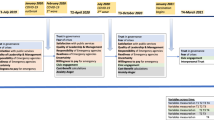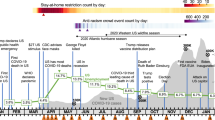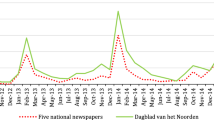Abstract
Extensive research has explored policy challenges associated with preparing and responding to a large-scale biological release. A key component in recovery strategy development that has received less attention is the understanding of government policy influence on the impacted populations’ migratory decisions. This study experimentally manipulates health and economic government policies during response and recovery to assess the extent to which public migration is contingent on the level of government intervention. Set immediately following a large-scale anthrax release in San Francisco, we use a five episode video scenario to describe details about the environmental impacts of the disaster, emergency response procedures, and clean-up operations. Within these video segments, the extent of government involvement in economic and health risk policies is manipulated. Using these manipulations as predictors, we track how varying levels of government risk signals influence migration behavior at three distinct decision points during disaster recovery. In addition, two belief scales and two scales of emotion (affect) are included as predictors to explore the potential for their mediating role in explaining intentions to migrate. We find that the decision to migrate is highly context-sensitive, with each decision point showing a unique combination of significant predictors influencing decision making. At 19 days following the anthrax release, the health risk policy manipulation has both a direct and indirect effect on migration behavior. At 3 months, the influence of the health risk policy manipulation is mediated by beliefs, and at 1 year, only indirect effects associated with affect and beliefs influence migration.








Similar content being viewed by others
Notes
Copies of the videos developed for the scenario simulation are available upon request to rosoff@usc.edu.
Additional analyses were run using gender, income, age, and whether or not the participant had children as covariates/potential moderators, and no significant results were found.
References
Adams RE, Boscarino JA (2005) Stress and well-being in the aftermath of the World Trade Center attack: the continuing effects of a communitywide disaster. J Community Psychol 33:175–190. doi:10.1002/jcop.20030
Bar-Anan Y, Liberman N, Trope Y (2006) The association between psychological distance and construal level: evidence from an implicit association test. J Exp Psychol Gen 135:609–622
Berke PR, Campanella TJ (2006) Planning for postdisaster resiliency. Ann Am Acad Polit Soc Sci 604:192–207
Bonanno GA (2004) Loss, trauma, and human resilience: have we underestimated the human capacity to thrive after extremely aversive events? Am J Psychol 59:20–28
Brunsma DL, Overfelt DJ, Picou S (2007) The sociology of katrina: perspectives on a modern catastrophe. Rowman & Littlefield, Maryland
Burke R (2005) Effects of 9/11 on individuals and organizations: down but not out! Disaster Prev Manag 14:629–638
Burns WJ, Slovic P (2007) The diffusion of fear: modeling community response to a terrorist strike. J Def Model Simul Appl Method Technol 4:1–20
Castellanos MB (2010) Solidarity in the aftermath of disaster: Cancún after Hurricane Wilma. Anthropol Now 2:37–48
Department of the Army (1977) U.S. army activity in the U.S. biological warfare programs, vol II. Publication DTIC B193427L, Washington
Fiedler K (2007) Construal level theory as an integrative framework for behavioral decision-making research and consumer psychology. J Consum Psychol 17:101–106
Franco C, Bouri N (2010) Environmental decontamination following a large-scale bioterrorism attack. Biosecur Bioterror 8:107–117
Giesecke JA, Burns WJ, Barrett A, Bayrak E, Rose A, Slovic P, Suher M (2012) Assessment of the regional economic impacts of catastrophic events: CGE analysis of resource loss and behavioral effects of a RDD attack scenario. Risk Anal 32:583–600
Godschalk D (2003) Urban hazard mitigation: creating resilient cities. Nat Hazards Rev 4:136–143
Gursky E, Inglesby T, O’Toole T (2003) Anthrax 2001: Observations on the Medical and Public Health Response. Biosec Bioterror Biodef Strateg Pract Sci 1:97–110
Hillel W, Cohen R, Victor W (2004) The pitfalls of bioterrorism preparedness: the anthrax and smallpox experiences. Am J Public Health 94:1667–1671
Hodgson W (2007) Emotions and sense making in disturbance: community adaptation to dangerous environments. Hum Ecol Rev 14:233–242
Kortepeter M, Parker G (2009) Potential biological weapons threats. Emerg Infect Dis 5:523–527
Kweit M, Kweit R (2004) Citizen participation and citizen evaluation in disaster recovery. Am Rev Public Adm 34:354–373
Loewenstein G, Weber E, Hsee C, Welch N (2001) The dynamics of evolving beliefs, concerns emotions, and behavioral avoidance following 9/11: a longitudinal analysis of representative archival samples. Psychol Bull 127:267–286
McArdle SC, Rosoff H, John RS (2012) The Dynamics of evolving beliefs, concerns emotions, and behavioral avoidance following 9/11: a longitudinal analysis of representative archival samples. Risk Anal 32:744–761
Mileti D, Gailus JL (2005) Sustainable development and hazards mitigation in the United States: disasters by design revisited. Mitig Adapt Strateg Glob Chang 10:491–504
Patterson O, Weil F, Patel K (2010) The Role of community in disaster response: conceptual models. Popul Res Policy Rev 29:127–141
Paxson C, Rouse CE (2008) Returning to New Orleans after Hurricane Katrina. Am Econ Rev 98:38–42
Pearce L (2003) Disaster management and community planning, and public participation: how to achieve sustainable hazard mitigation. Nat Hazards 28:211–228
Pfister HR, Böhm G (2008) The multiplicity of emotions: A framework of emotional functions in decision making. Judgm decis mak 3:5–17
Pidgeon N, Kasperson R, Slovic P (2003) The social amplification of risk. University Press, Cambridge
Rosoff H, John RS, Burns W, Maya I (2011) Scenario simulation group reactions to the aftermath of the great shake-out magnitude 7.8 earthquake. Earthq Spectra 27:597–614
Rosoff H, John RS, Prager F (2012a) Flu, risks, and videotape: escalating fear and avoidance. Risk Anal 32:729–743
Rosoff H, John RS, Burns W, Siko R (2012b) Structuring uncertainty and conflicting objectives for life or death decisions following an urban biological catastrophe. J Integr Disaster Risk Manag. doi:10.5595/idrim.2012.0035
Runge JW (2008) Assistant Secretary for Health Affairs, Department of Homeland Security, written testimony before the House Committee on Homeland Security, July 22, 2008
Slovic P (1987) Perception of risk. Science 236:280–285
Slovic P, Finucane ML, Peters E, MacGregor DG (2004) Risk as analysis and risk as feelings: some thoughts about affect, reason, risk, and rationality. Risk Anal 24:311–322. doi:10.1111/j.0272-4332.2004.00433.x
Tierney KJ, Bevc C, Kuligowski E (2006) Metaphors matter: disaster myths, media frames, and their consequences in Hurricane Katrina. Ann Am Acad Polit Soc Sci 604:57–81
Trope Y, Liberman N (2010) Construal level theory of psychological distance. Psychol Rev 117:440–463
Watson D, Clark LA, Tellegen A (1988) Development and validation of brief measures of positive and negative affect: the PANAS scales. J Perspect Soc Psychol 54:1063–1070
Weick K, Sutcliffe KM, Obstfeld D (2005) Organizing and the process of sensemaking. Organ Sci 16:409–421
Weis CP, Intrepido AJ, Miller AK, Cowin PG, Durno MA, Gebhardt JS, Bull R (2002) Secondary aerosolization of viable Bacillus anthracis spores in a contaminated US Senate Office. JAMA 288:2853–2858
Author information
Authors and Affiliations
Corresponding author
Rights and permissions
About this article
Cite this article
Rosoff, H., Siko, R., John, R. et al. Should I stay or should I go? An experimental study of health and economic government policies following a severe biological agent release. Environ Syst Decis 33, 121–137 (2013). https://doi.org/10.1007/s10669-012-9431-4
Published:
Issue Date:
DOI: https://doi.org/10.1007/s10669-012-9431-4




